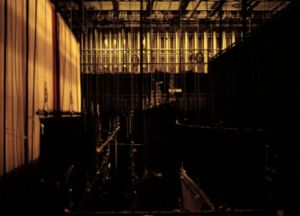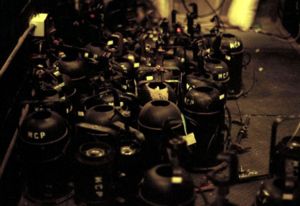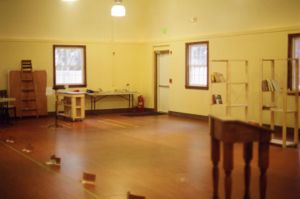Westport Country Playhouse
2007 Schools Wikipedia Selection. Related subjects: Theatre
The Westport Country Playhouse is a theatre in Westport, Connecticut, founded in 1930 by Lawrence Langner and his wife Armina Marshall. It is a non-profit theatre currently run by Tazewell Thompson, Anne Keefe, and Joanne Woodward. It recently underwent a $30.6 million renovation, and now has a 578-seat theatre space. The Playhouse is one of the best-known regional theatres in Connecticut, having been described as a "mecca" for apprentices and interns.
History
The building that is now the Westport Country Playhouse was originally constructed in 1835 as a tannery by R&H Haight, owned by Henry Haight. After Haight's death in 1860, the plant was purchased by Charles H. Kemper.
In 1930, the former tannery, which had been unused since the 1920s, was purchased for $14,000 by Lawrence Langner. Cleon Throckmorten, a Broadway designer, was commissioned to renovate the interior of the building.
In 1931, the curtain went up on the first production at the Westport Country Playhouse. In order to more easily transfer Playhouse productions to Broadway, the stage was built to match the specifications of Broadway’s Times Square Theatre on 42nd Street. The idea proved immediately useful when the playhouse's first production, The Streets of New York (starring Dorothy Gish), transferred to Broadway. Dozens of new works followed suit over the years.
When it came to casting, Langner turned to well-known actor acquaintances and friends such as Eugene O'Neill and George Bernard Shaw when he needed new plays. The Playhouse's strong launch enhanced its reputation among the acting community. Wealthy theatre patrons and supporters in nearby Fairfield County towns helped it survive and thrive.
In the 1940s, the Playhouse began its apprentice program for young theatre professionals. Over the years, Playhouse apprentices have included composer/lyricist Stephen Sondheim, screenwriter Frank Perry, television host Sally Jesse Raphael, composer Mary Rodgers, actor Carey Elwes, and actress Tammy Grimes. The educational apprenticeship programs are still running.
The Playhouse closed due to World War II from 1942 to 1945. In the late 1940s and 1950s, the playhouse's successes included world premieres of William Inge's Come Back, Little Sheba and Horton Foote's The Trip to Bountiful, both of which went on to Broadway.
Since the Langners stepped down in 1959, the administration has included James B. McKenzie from 1959 to 2000 and actress Joanne Woodward, Paul Newman's wife, who took over as artistic director in 2000. Newman is now part-owner of a restaurant next to the theatre.
By 2000, more than 700 plays had been produced and almost four million people had attended the theatre.
In 2002 the playhouse transferred its first production to Broadway after more than 35 years.
Woodward and Alison Harris, executive director, led a $30.6 million renovation, transforming the old barn into a modern, year-round theatre facility. The renovated theatre reopened in 2005. Woodward stepped down from her job in January 2006, and was followed by actor, opera and theatre director, and playwright Tazewell Thompson. However, Woodward and Newman have both continued to contribute to the Playhouse's "Campaign for a New Era".
Harris, executive director since 2000, announced in 2005 that she would not be renewing her contract when it expired in 2006, and in the summer of 2006 she resigned.
The Playhouse has provided a stage for many new playwrights over the years. David Wiltse is the current playwright in residence, writing one play for the playhouse to produce each year.
Campaign for a New Era
The Campaign for a New Era is the fundraising effort by the Westport Country Playhouse to help pay for its $30.6 million, 18-month renovation. Donations of more than $1,000 are recognized within the Playhouse's lobby and programs. Some of the largest donations came from the state of Connecticut, the Devlin Foundation, the Lucille Lortel foundation, Elizabeth & Stanley Morten, and Joanne Woodward & Paul Newman.
Technical
Seating
The Playhouse currently has a total of 578 seats. This is lower seating capacity than before the renovation, but the seats are now individual and cushioned, as opposed to the former wooden pews, while retaining the historic look of the former pews. Further, fewer of the current seats are considered "limited view" since the renovations.
The 578 seats are distributed as follows:
- 424 orchestra
- 234 centre orchestra
- 93 house left orchestra
- 97 house right orchestra
- 154 mezzanine
- 118 centre mezzanine
- 18 left mezzanine boxes
- 18 right mezzanine boxes
Several seats in both the orchestra and mezzanine can be removed or modified to be wheelchair accessible.
Stage
- Stage:
- Height: 3 feet 2 inches (.97m) above house floor
- Depth: 26 feet 2 inches (7.98m) deep from plaster line to back wall, 2 feet 1 inch (.64m) apron below plaster line, 28 feet 3 inches (8.61m) total depth
- Wing Space: 13 feet 6 inches (4.11m) clear stage right, 24 feet 6 inches (7.47m) clear stage left
- Proscenium:
- Height: 15 feet 3 inches (4.65m) above stage floor
- Width: 32 feet 9 inches (9.98m) wide
- Orchestra pit:
- Depth: 9 feet 3 inches (2.82m) below stage floor
Fly system
The Playhouse has a counterweight fly system currently employing 22 battens, with space for future installations. The height from the stage to the grid is 40 feet (12.19m), with an effective fly range from 3 feet 10 inches (1.17m) to 38 feet (11.58m). Each arbor is 6 feet tall with a capacity for 1200 pounds (544 kg). The locking rail is on the stage right wall, and the loading bridge is 32 feet 3 inches (9.83m) above the stage floor.
Although the fly system and grid are designed for loads to be hung parallel to the proscenium, smaller loads can be hung perpendicular using cables independent of the actual arbor system. These have to be flown in and out manually from the grid, so perpendicularly hung loads are generally stationary during performances.
Lighting
Lighting is controlled from a Strand 520 console in a control booth at the back of the house. For technical rehearsals, a control position can be set up in the centre of the theatre.
The Playhouse's stage lighting instruments include:
- 2 - ETC Source Four 19° ERS
- 61 - ETC Source Four 26° ERS
- 58 - ETC Source Four 36° ERS
- 24 - ETC Source Four 50° ERS
- 18 - Altman 6 inch 500w Fresnels
- 7 - Altman 1 kw triple unit far cycs
- 42 - PAR 64
- 7 - T-6 six cell, three circuit, 4 foot 6 inches
- 6 - Birdies
Colour scrollers, irises, top hats, and barn doors (all lighting instrument attachments) are also available. On-stage film and projection equipment are only available through special arrangement.
Education
Of the hundreds of interns and apprentices who have passed through the Playhouse's educational programs, several have gone on to attain notoriety. Some graudates include Stephen Sondheim, Frank Perry, Tammy Grimes, Sally Jessy Raphael, Mary Rodgers and Christina Crawford. Others have been related to notable performers. The 1959 alumni alone include Jon de Vries (son of Westport playwright Peter de Vries), Tim Sinnemann (son of Hollywood director Fred Sinnemann), and Lisa Whitman (granddaughter of Cornelia Otis Skinner). A large number of Playhouse interns and apprentices have made careers in the theatre or in related activities.
Woodward Internship Program
The Westport Country Playhouse provides summer and school year internships to students ages 19 and older from around the country. The interns are entrusted with considerable responsibilities and treated as staff members while they engage in an intensive learning experience. Each intern is hired for a specific position, but interns are expected to work as a team and pitch in where necessary, including, but not limited to, running crew, ushering, concessions and parking.
The program is named in honour of Joanne Woodward, the current Artistic Director Emeritus. Accepted applicants must be serious minded, highly motivated and able to commit a minimum of twelve weeks, with long working hours as many as 7 days a week. Applicants should be a college students, graduate students or recent graduates, with basic training and experience in theatre already completed, prepared to take the next step towards a professional theatre career.
Woodward Apprenticeship Program
The Westport Country Playhouse also has a summer apprenticeship program for students aged 15 to 18. Each year, approximately 10 apprentices are selected from those who apply. The program lasts approximately eight weeks, usually starting in June and ending in August. The apprenticeship is 7 to 12 hours per day, often 7 days per week, and, with rare exceptions, there is little time off. Many of the apprentices live in Westport and neighboring towns, but some come from other states.
The program is designed to give the apprentices experience in every aspect of working in a professional theatre. Each apprentice is part of the running crew for one show during the summer season. Alternately, apprentices can volunteer to work on a show before or after the apprenticeship. During performances, those who are not on the current running crew do front of house work, including ushering, parking cars, and managing concessions.
Before and after performances, time is divided into classes, work rotations, and artist hours. The classes cover a range of subjects, including script analysis, acting, directing, auditioning, and dialects. During work rotations, apprentices help the Playhouse crews complete tasks in areas including props, set construction, and scenic painting as well as taining in the box office. Artist hours are open discussions with professionals from all fields of theatre; past artists have included actors Gene Wilder and Paul Newman, producer Bill Haber, and the casts and crews of current shows.
The program culminates with the Apprentice Showcase, with the apprentices writing, designing, and performing a play. All apprentices are encouraged to take part in the writing process, which takes place throughout the second half of the program. Once the script has been finalized, the roles and technical positions are assigned among the apprentices. There is one week of rehearsal, and one free admission performance. The schedule is designed to simulate that of a traditional summer stock theatre.
Current administration
The current administration of the Playhouse includes:
Board of Directors
- Chairman: Elisabeth Morton
- President: John A. Vaccaro
- Vice Presidents: Harold Baily, Jr. and Sharon Sullivan
- Treasurer: Steven Wolff
- Secretary: Ann Sheffer
Staff
- Artistic Director: Tazewell Thompson
- Executive Director: Position currently vacant
- Associate Artistic Director:
- Artistic Director Emeritus: Joanne Woodward
Production
- Production Coordinator: Liz Liles
- Technical Director: John Mosele
- Master Electrician: Janie Flowers
- Company Manager: Bruce Miller
Notable performers
Many notable performers have enhanced the Westport Country Playhouse stage from 1930 to the present, including such well-known names as Kitty Carlisle, Henry Fonda, Olivia de Havilland, Eva Gabor, Michael Allinson and Jane Fonda.


